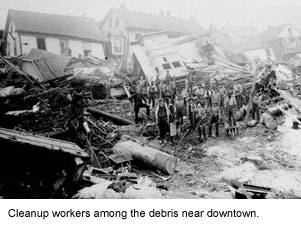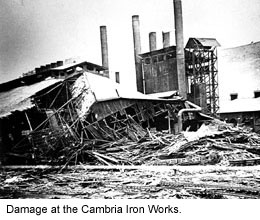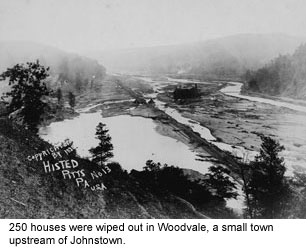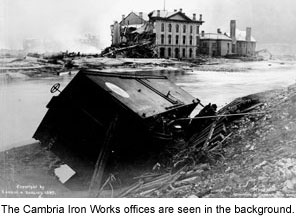Help keep the story of the Johnstown Flood alive for a new generation! David McCullough, author of The Johnstown Flood, has endorsed our $2.5 million campaign to refurbish and renovate the Johnstown Flood Museum, as seen below.
By the morning of May 31, 1889, there was water in the streets. Business people were moving their wares to the upper stories of their buildings. Families moved furnishings and supplies they would need to wait out the deluge.
Johnstown had been built into a river valley on the Appalachian Plateau. The Little Conemaugh and the Stony Creek Rivers, which ran along the peripheral of the town and merged to form the Conemaugh River at the western end, drained a 657 square mile watershed which dropped in the rivers from mountains 500 feet above. At least once a year, one or both of the rivers overflowed into the streets sending the town’s residents into a scurry to protect what they could of their homes and belongings.
 Some of these floods were caused when heavy snows melted too quickly in the spring. And others, at any season of the year, when a heavy rain fell over the area. Whichever, floods were a fact of life to the nineteenth century resident of this industrial community in southwestern Pennsylvania. And, in the late afternoon of May 31, 1889, people were gathered in the upper stories of their homes, waiting out the worst of it, just as they had done many times before.
Some of these floods were caused when heavy snows melted too quickly in the spring. And others, at any season of the year, when a heavy rain fell over the area. Whichever, floods were a fact of life to the nineteenth century resident of this industrial community in southwestern Pennsylvania. And, in the late afternoon of May 31, 1889, people were gathered in the upper stories of their homes, waiting out the worst of it, just as they had done many times before.
Even as the residents of Johnstown prepared for their long wait, activity at the South Fork dam, just 14 miles above the city was frantic. The South Fork dam held back Lake Conemaugh, the pleasure lake of the South Fork Fishing and Hunting Club, a prestigious club which included such famed entrepreneurs as Andrew Carnegie and Henry Clay Frick on its membership rolls. (Click here for more information about the club and the dam; a list of club members is also available there). Officials there feared the dam would fail. Since midmorning, they’d worked to avoid this, because they feared the consequences. The lake was a little over two miles long, a little over a mile wide at its widest spot, and 60 feet deep at the dam itself.
 Among the attempts were efforts to add height to the dam, then to dig a second spillway to relieve pressure from the breast, and finally to release the heavy screens placed on the overflows to keep the stocked fish from escaping into the streams below. By a little after 3 p.m., when most people in Johnstown were settling in to be marooned for the evening, club officials and the laborers they recruited, as well as a good sized audience from the little community of South Fork just below the dam, watched in dumbfounded horror as the dam “just moved away. ”
Among the attempts were efforts to add height to the dam, then to dig a second spillway to relieve pressure from the breast, and finally to release the heavy screens placed on the overflows to keep the stocked fish from escaping into the streams below. By a little after 3 p.m., when most people in Johnstown were settling in to be marooned for the evening, club officials and the laborers they recruited, as well as a good sized audience from the little community of South Fork just below the dam, watched in dumbfounded horror as the dam “just moved away. ”
Within the hour, a body of water which engineers at the time estimated moved into the valley with the force of Niagara Falls, rolled into Johnstown with 14 miles of accumulated debris, which included houses, barns, animals and people, dead and alive.
 Those who saw it coming described it as a rolling hill of debris about 40 feet high and a half-mile wide. But most only heard the thunderous rumble as it swept into the city to add Johnstown to a wake that already included bits and pieces of the communities of South Fork, Mineral Point, Woodvale and East Conemaugh.
Those who saw it coming described it as a rolling hill of debris about 40 feet high and a half-mile wide. But most only heard the thunderous rumble as it swept into the city to add Johnstown to a wake that already included bits and pieces of the communities of South Fork, Mineral Point, Woodvale and East Conemaugh.
Some continued to wait out the disaster in their houses, others were picked up by the flood wave for a wild ride through the town to the Pennsylvania Railroad Company’s Stone Bridge where debris piled 40 feet high and over 30 acres, then caught fire. Still others were shot down the Conemaugh River to die or be rescued at Nineveh, Bolivar or other communities downstream.
 Six-year-old Gertrude Quinn Slattery was one of those caught in the flood wave. Years later she would write about her experience as she was hurled through the torrents on what she describes as a “raft with a wet muddy mattress and bedding.”
Six-year-old Gertrude Quinn Slattery was one of those caught in the flood wave. Years later she would write about her experience as she was hurled through the torrents on what she describes as a “raft with a wet muddy mattress and bedding.”
“I had great faith that I would not be abandoned,” she wrote. “While my thoughts were thus engaged, a large roof came floating toward me with about twenty people on it. I cried and called across the water to them to help me. This, of course they could not do. The roof was big, and they were all holding on for dear life, feeling every minute that they would be tossed to death. While I watched I kept praying, calling, and begging someone to save me. Then I saw a man come to the edge, the others holding him and talking excitedly. I could see they were trying to restrain him but he kept pulling to get away which he finally did, and plunged into the swirling waters and disappeared.
 Then his head appeared and I could see he was looking in my direction and I called, cried, and begged him to come to me. He kept going down and coming up, sometimes lost to my sight entirely, only to come up next time much closer to my raft. The water was now between fifteen and twenty feet deep.
Then his head appeared and I could see he was looking in my direction and I called, cried, and begged him to come to me. He kept going down and coming up, sometimes lost to my sight entirely, only to come up next time much closer to my raft. The water was now between fifteen and twenty feet deep.
“As I sat watching this man struggling in the water my mind was firmly fixed on the fact that he was my saviour. At last he reached me, drew himself up and over the side of the mattress and lifted me up. I put both arms around his neck and held on to him like grim death. Together we went downstream with the ebb and flow of the reflex to the accompaniment of crunching, grinding, gurgling, splashing and crying and moaning of many. After drifting about we saw a little white building, standing at the edge of the water, apparently where the hill began. At the window were two men with poles helping to rescue people floating by. I was too far out for the poles, so the men called:
‘Throw that baby over here to us.’
“My hero said: ‘Do you think you can catch her?’
“They said: ‘We can try.'”
 “So Maxwell McAchren threw me across the water (some say twenty feet, others fifteen. I could never find out, so I leave it to your imagination. It was considered a great feat in the town, I know.)”
“So Maxwell McAchren threw me across the water (some say twenty feet, others fifteen. I could never find out, so I leave it to your imagination. It was considered a great feat in the town, I know.)”
The response to the disaster was immediate as over 100 newspapers and magazines sent writers and illustrators to Johnstown to recount the story for the world.
Although not noted for their accuracy, the reports touched the hearts of the readers. People sent money, clothing, and food. Medical societies and doctors and hospitals sent medicines and bandages. Doctors left their practices and hurried to Johnstown to assist. Lumber was sent for rebuilding houses and businesses.
The dead were lined up in morgues throughout the city and in communities further down the Conemaugh River until some survivor in search of a loved one came to identify them. Although damaged itself, the Presbyterian Church on Main Street was the site of one of the morgues. A reporter from the New York Evening Post described the scene there.
 “The first floor has been washed out completely and the second, while submerged, was badly damaged, but not ruined. The walls, floors, and pews were drenched and the mud has collected on the mattings and carpets an inch deep. Walking is attended with much difficulty, and the undertakers and attendants, with arms bared, slide about the slippery surface at a tremendous rate. The chancel is filled with coffins, strips of muslin, boards and all undertaking accessories. Lying across the top of the pews are a dozen pine boxes each containing a victim of the flood. Printed cards are tacked to each. Upon them the sex and full description of the enclosed body is written with the name of the known.” (Click here for a list of flood victims, their addresses, ages and burial places).
“The first floor has been washed out completely and the second, while submerged, was badly damaged, but not ruined. The walls, floors, and pews were drenched and the mud has collected on the mattings and carpets an inch deep. Walking is attended with much difficulty, and the undertakers and attendants, with arms bared, slide about the slippery surface at a tremendous rate. The chancel is filled with coffins, strips of muslin, boards and all undertaking accessories. Lying across the top of the pews are a dozen pine boxes each containing a victim of the flood. Printed cards are tacked to each. Upon them the sex and full description of the enclosed body is written with the name of the known.” (Click here for a list of flood victims, their addresses, ages and burial places).
The living set up tents, often near to the places their former homes had been located and began what must of been perceived of as the impossible task of cleaning up and starting life again. Clara Barton and her Washington, D . C . contingent of the Red Cross built hotels for people to live in and warehouses to store the many supplies the community received (click here for more on the Red Cross in Johnstown). By July 1, stores opened on the Main Street for business. The Cambria Iron Company reopened on June 6. Five years later, an observer would have been hard pressed to imagine the destruction in the valley on May 31, 1889.
Yet no city, county, or state legislation was enacted to protect people from similar disasters in the future. Suits were filed against the members of the South Fork Fishing and Hunting Club, but in keeping with the times, the courts viewed the dam break as an act of God, and no legal compensation was made to the survivors.
The city would continue to suffer nuisance floods, with water in the streets and in people’s basements especially in the spring of the year. It would be another 47 years, and not until more property was destroyed and more lives lost, until some constructive efforts were made to control the waters that flowed through Johnstown.
This narrative about the 1889 flood is by Edwin Hutcheson, excerpted from “Floods of Johnstown: 1889-1936 -1977,” published in 1989 by the Cambria County Tourist Council.
For more, visit the section about the 1889 flood in the Archives & Research section of this site.
More 1889 flood resources